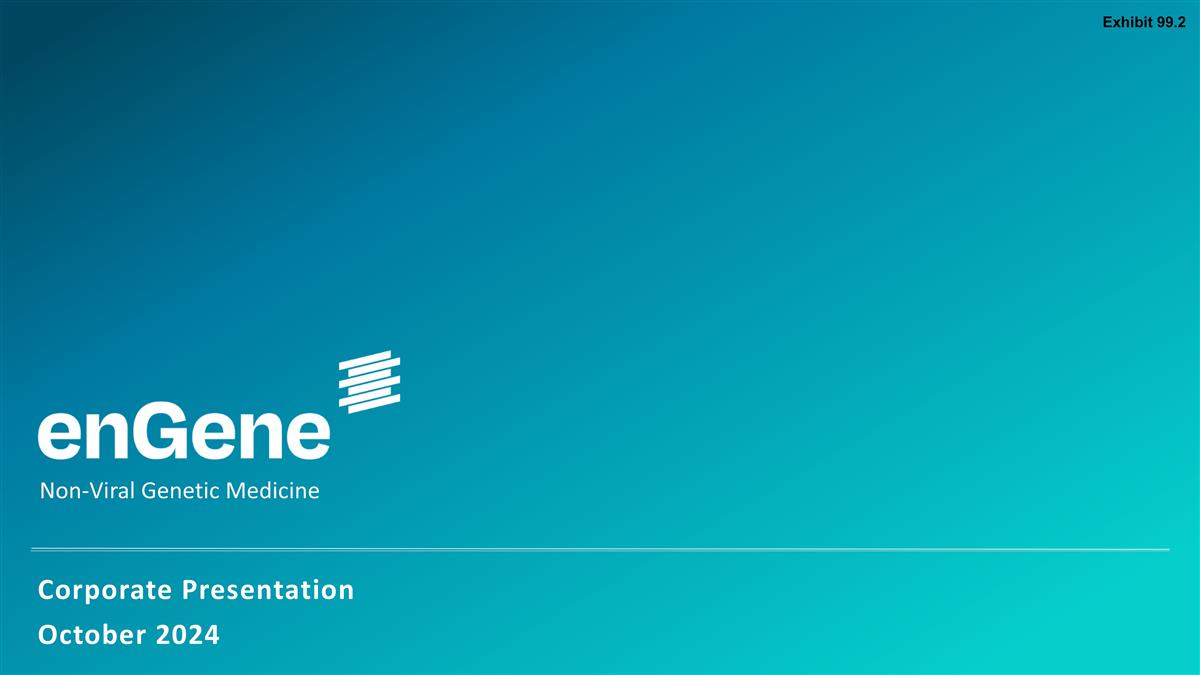
Non-Viral Genetic Medicine Corporate Presentation October 2024 Exhibit 99.2
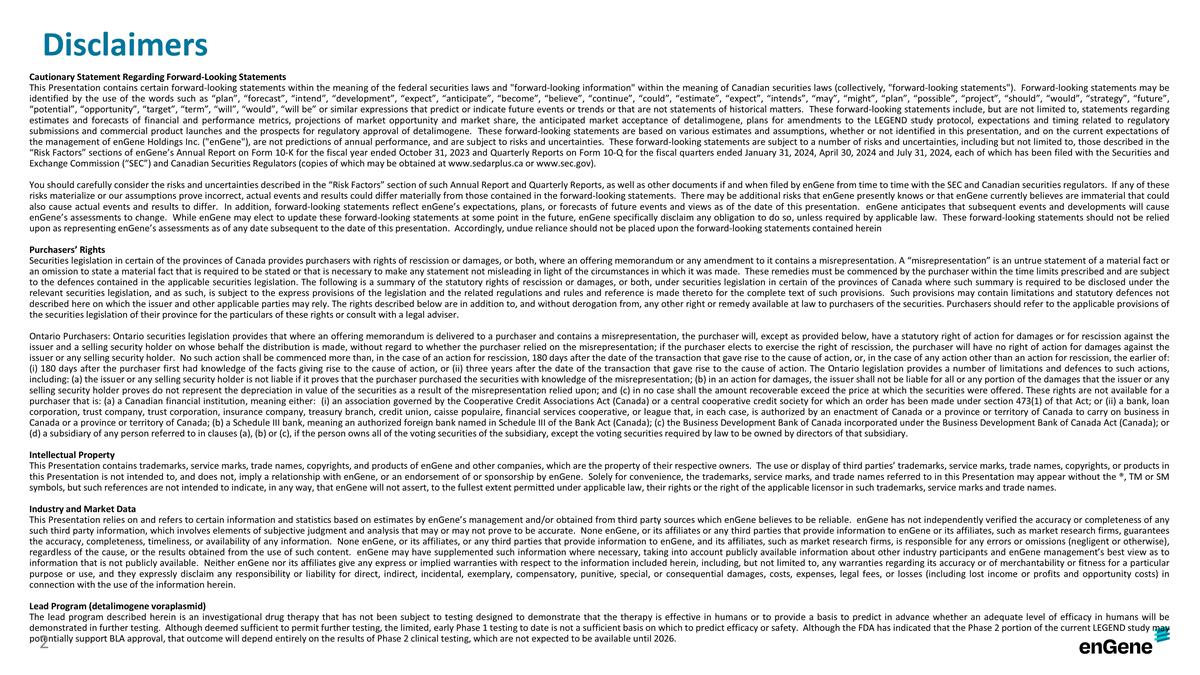
Cautionary Statement Regarding Forward-Looking Statements This Presentation contains certain forward-looking statements within the meaning of the federal securities laws and "forward-looking information" within the meaning of Canadian securities laws (collectively, "forward-looking statements"). Forward-looking statements may be identified by the use of the words such as “plan”, “forecast”, “intend”, “development”, “expect”, “anticipate”, “become”, “believe”, “continue”, “could”, “estimate”, “expect”, “intends”, “may”, “might”, “plan”, “possible”, “project”, “should”, “would”, “strategy”, “future”, “potential”, “opportunity”, “target”, “term”, “will”, “would”, “will be” or similar expressions that predict or indicate future events or trends or that are not statements of historical matters. These forward-looking statements include, but are not limited to, statements regarding estimates and forecasts of financial and performance metrics, projections of market opportunity and market share, the anticipated market acceptance of detalimogene, plans for amendments to the LEGEND study protocol, expectations and timing related to regulatory submissions and commercial product launches and the prospects for regulatory approval of detalimogene. These forward-looking statements are based on various estimates and assumptions, whether or not identified in this presentation, and on the current expectations of the management of enGene Holdings Inc. ("enGene"), are not predictions of annual performance, and are subject to risks and uncertainties. These forward-looking statements are subject to a number of risks and uncertainties, including but not limited to, those described in the “Risk Factors” sections of enGene’s Annual Report on Form 10-K for the fiscal year ended October 31, 2023 and Quarterly Reports on Form 10-Q for the fiscal quarters ended January 31, 2024, April 30, 2024 and July 31, 2024, each of which has been filed with the Securities and Exchange Commission (“SEC”) and Canadian Securities Regulators (copies of which may be obtained at www.sedarplus.ca or www.sec.gov). You should carefully consider the risks and uncertainties described in the “Risk Factors” section of such Annual Report and Quarterly Reports, as well as other documents if and when filed by enGene from time to time with the SEC and Canadian securities regulators. If any of these risks materialize or our assumptions prove incorrect, actual events and results could differ materially from those contained in the forward-looking statements. There may be additional risks that enGene presently knows or that enGene currently believes are immaterial that could also cause actual events and results to differ. In addition, forward-looking statements reflect enGene’s expectations, plans, or forecasts of future events and views as of the date of this presentation. enGene anticipates that subsequent events and developments will cause enGene’s assessments to change. While enGene may elect to update these forward-looking statements at some point in the future, enGene specifically disclaim any obligation to do so, unless required by applicable law. These forward-looking statements should not be relied upon as representing enGene’s assessments as of any date subsequent to the date of this presentation. Accordingly, undue reliance should not be placed upon the forward-looking statements contained herein Purchasers’ Rights Securities legislation in certain of the provinces of Canada provides purchasers with rights of rescission or damages, or both, where an offering memorandum or any amendment to it contains a misrepresentation. A “misrepresentation” is an untrue statement of a material fact or an omission to state a material fact that is required to be stated or that is necessary to make any statement not misleading in light of the circumstances in which it was made. These remedies must be commenced by the purchaser within the time limits prescribed and are subject to the defences contained in the applicable securities legislation. The following is a summary of the statutory rights of rescission or damages, or both, under securities legislation in certain of the provinces of Canada where such summary is required to be disclosed under the relevant securities legislation, and as such, is subject to the express provisions of the legislation and the related regulations and rules and reference is made thereto for the complete text of such provisions. Such provisions may contain limitations and statutory defences not described here on which the issuer and other applicable parties may rely. The rights described below are in addition to, and without derogation from, any other right or remedy available at law to purchasers of the securities. Purchasers should refer to the applicable provisions of the securities legislation of their province for the particulars of these rights or consult with a legal adviser. Ontario Purchasers: Ontario securities legislation provides that where an offering memorandum is delivered to a purchaser and contains a misrepresentation, the purchaser will, except as provided below, have a statutory right of action for damages or for rescission against the issuer and a selling security holder on whose behalf the distribution is made, without regard to whether the purchaser relied on the misrepresentation; if the purchaser elects to exercise the right of rescission, the purchaser will have no right of action for damages against the issuer or any selling security holder. No such action shall be commenced more than, in the case of an action for rescission, 180 days after the date of the transaction that gave rise to the cause of action, or, in the case of any action other than an action for rescission, the earlier of: (i) 180 days after the purchaser first had knowledge of the facts giving rise to the cause of action, or (ii) three years after the date of the transaction that gave rise to the cause of action. The Ontario legislation provides a number of limitations and defences to such actions, including: (a) the issuer or any selling security holder is not liable if it proves that the purchaser purchased the securities with knowledge of the misrepresentation; (b) in an action for damages, the issuer shall not be liable for all or any portion of the damages that the issuer or any selling security holder proves do not represent the depreciation in value of the securities as a result of the misrepresentation relied upon; and (c) in no case shall the amount recoverable exceed the price at which the securities were offered. These rights are not available for a purchaser that is: (a) a Canadian financial institution, meaning either: (i) an association governed by the Cooperative Credit Associations Act (Canada) or a central cooperative credit society for which an order has been made under section 473(1) of that Act; or (ii) a bank, loan corporation, trust company, trust corporation, insurance company, treasury branch, credit union, caisse populaire, financial services cooperative, or league that, in each case, is authorized by an enactment of Canada or a province or territory of Canada to carry on business in Canada or a province or territory of Canada; (b) a Schedule III bank, meaning an authorized foreign bank named in Schedule III of the Bank Act (Canada); (c) the Business Development Bank of Canada incorporated under the Business Development Bank of Canada Act (Canada); or (d) a subsidiary of any person referred to in clauses (a), (b) or (c), if the person owns all of the voting securities of the subsidiary, except the voting securities required by law to be owned by directors of that subsidiary. Intellectual Property This Presentation contains trademarks, service marks, trade names, copyrights, and products of enGene and other companies, which are the property of their respective owners. The use or display of third parties’ trademarks, service marks, trade names, copyrights, or products in this Presentation is not intended to, and does not, imply a relationship with enGene, or an endorsement of or sponsorship by enGene. Solely for convenience, the trademarks, service marks, and trade names referred to in this Presentation may appear without the ®, TM or SM symbols, but such references are not intended to indicate, in any way, that enGene will not assert, to the fullest extent permitted under applicable law, their rights or the right of the applicable licensor in such trademarks, service marks and trade names. Industry and Market Data This Presentation relies on and refers to certain information and statistics based on estimates by enGene’s management and/or obtained from third party sources which enGene believes to be reliable. enGene has not independently verified the accuracy or completeness of any such third party information, which involves elements of subjective judgment and analysis that may or may not prove to be accurate. None enGene, or its affiliates or any third parties that provide information to enGene or its affiliates, such as market research firms, guarantees the accuracy, completeness, timeliness, or availability of any information. None enGene, or its affiliates, or any third parties that provide information to enGene, and its affiliates, such as market research firms, is responsible for any errors or omissions (negligent or otherwise), regardless of the cause, or the results obtained from the use of such content. enGene may have supplemented such information where necessary, taking into account publicly available information about other industry participants and enGene management’s best view as to information that is not publicly available. Neither enGene nor its affiliates give any express or implied warranties with respect to the information included herein, including, but not limited to, any warranties regarding its accuracy or of merchantability or fitness for a particular purpose or use, and they expressly disclaim any responsibility or liability for direct, indirect, incidental, exemplary, compensatory, punitive, special, or consequential damages, costs, expenses, legal fees, or losses (including lost income or profits and opportunity costs) in connection with the use of the information herein. Lead Program (detalimogene voraplasmid) The lead program described herein is an investigational drug therapy that has not been subject to testing designed to demonstrate that the therapy is effective in humans or to provide a basis to predict in advance whether an adequate level of efficacy in humans will be demonstrated in further testing. Although deemed sufficient to permit further testing, the limited, early Phase 1 testing to date is not a sufficient basis on which to predict efficacy or safety. Although the FDA has indicated that the Phase 2 portion of the current LEGEND study may potentially support BLA approval, that outcome will depend entirely on the results of Phase 2 clinical testing, which are not expected to be available until 2026. Disclaimers
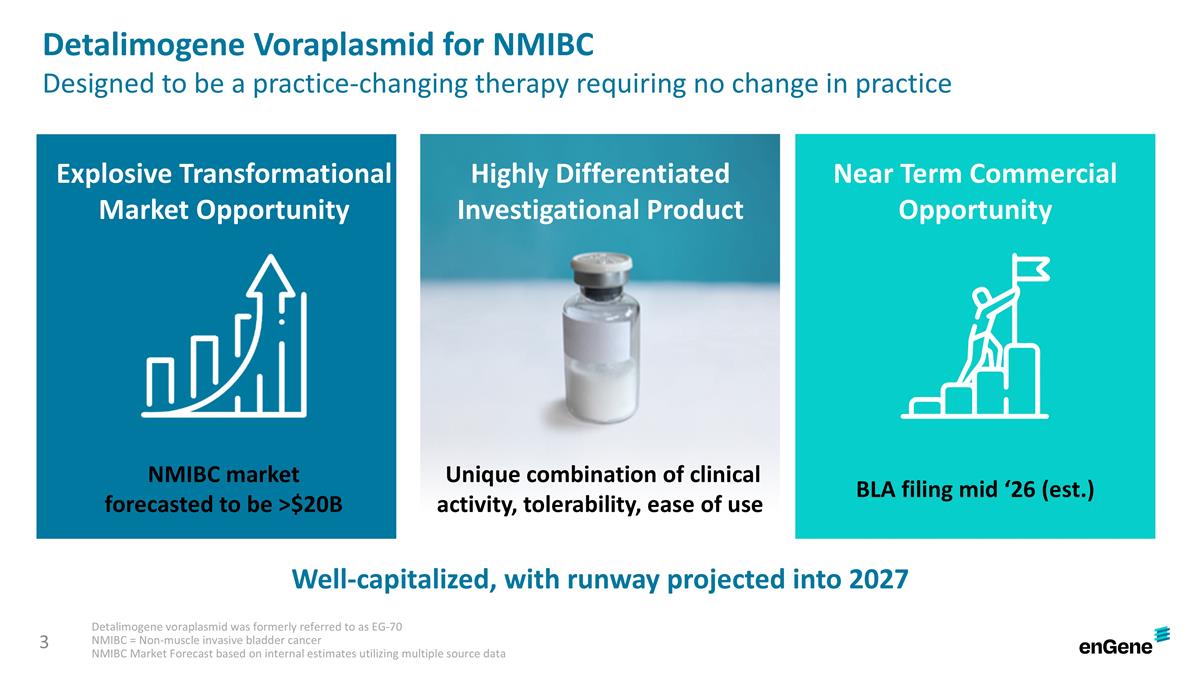
Detalimogene Voraplasmid for NMIBC Designed to be a practice-changing therapy requiring no change in practice Detalimogene voraplasmid was formerly referred to as EG-70 NMIBC = Non-muscle invasive bladder cancer NMIBC Market Forecast based on internal estimates utilizing multiple source data Highly Differentiated Investigational Product Explosive Transformational Market Opportunity Near Term Commercial Opportunity Well-capitalized, with runway projected into 2027 BLA filing mid ‘26 (est.) Unique combination of clinical activity, tolerability, ease of use NMIBC market forecasted to be >$20B
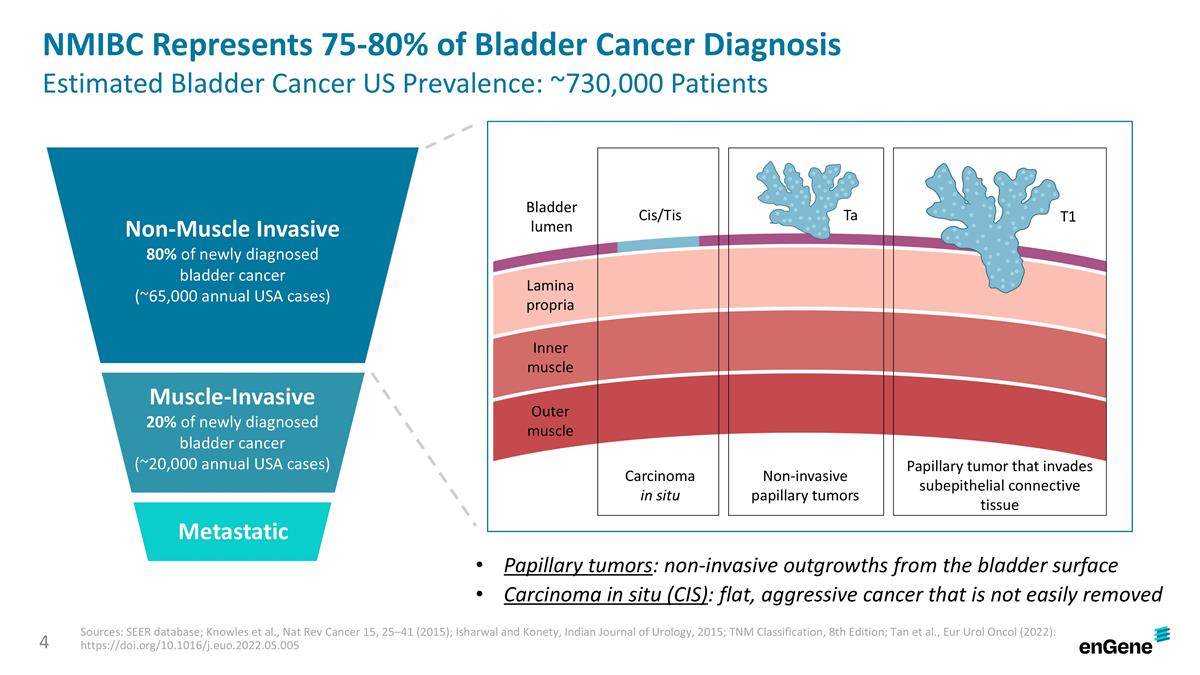
NMIBC Represents 75-80% of Bladder Cancer Diagnosis Estimated Bladder Cancer US Prevalence: ~730,000 Patients Non-Muscle Invasive 80% of newly diagnosed bladder cancer (~65,000 annual USA cases) Muscle-Invasive 20% of newly diagnosed bladder cancer (~20,000 annual USA cases) Metastatic Papillary tumors: non-invasive outgrowths from the bladder surface Carcinoma in situ (CIS): flat, aggressive cancer that is not easily removed Sources: SEER database; Knowles et al., Nat Rev Cancer 15, 25–41 (2015); Isharwal and Konety, Indian Journal of Urology, 2015; TNM Classification, 8th Edition; Tan et al., Eur Urol Oncol (2022): https://doi.org/10.1016/j.euo.2022.05.005 Carcinoma in situ Non-invasive papillary tumors Papillary tumor that invades subepithelial connective tissue Outer muscle Inner muscle Lamina propria Bladder lumen Cis/Tis Ta T1
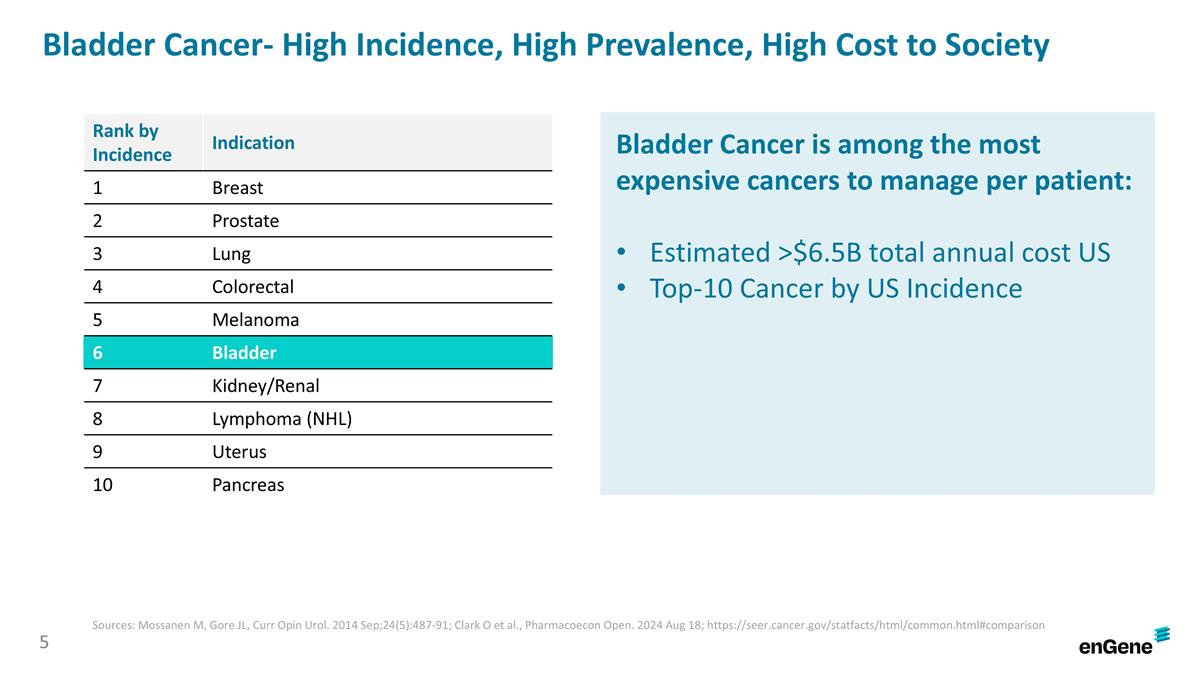
Bladder Cancer- High Incidence, High Prevalence, High Cost to Society Bladder Cancer is among the most expensive cancers to manage per patient: Estimated >$6.5B total annual cost US Top-10 Cancer by US Incidence Rank by Incidence Indication 1 Breast 2 Prostate 3 Lung 4 Colorectal 5 Melanoma 6 Bladder 7 Kidney/Renal 8 Lymphoma (NHL) 9 Uterus 10 Pancreas Sources: Mossanen M, Gore JL, Curr Opin Urol. 2014 Sep;24(5):487-91; Clark O et al., Pharmacoecon Open. 2024 Aug 18; https://seer.cancer.gov/statfacts/html/common.html#comparison
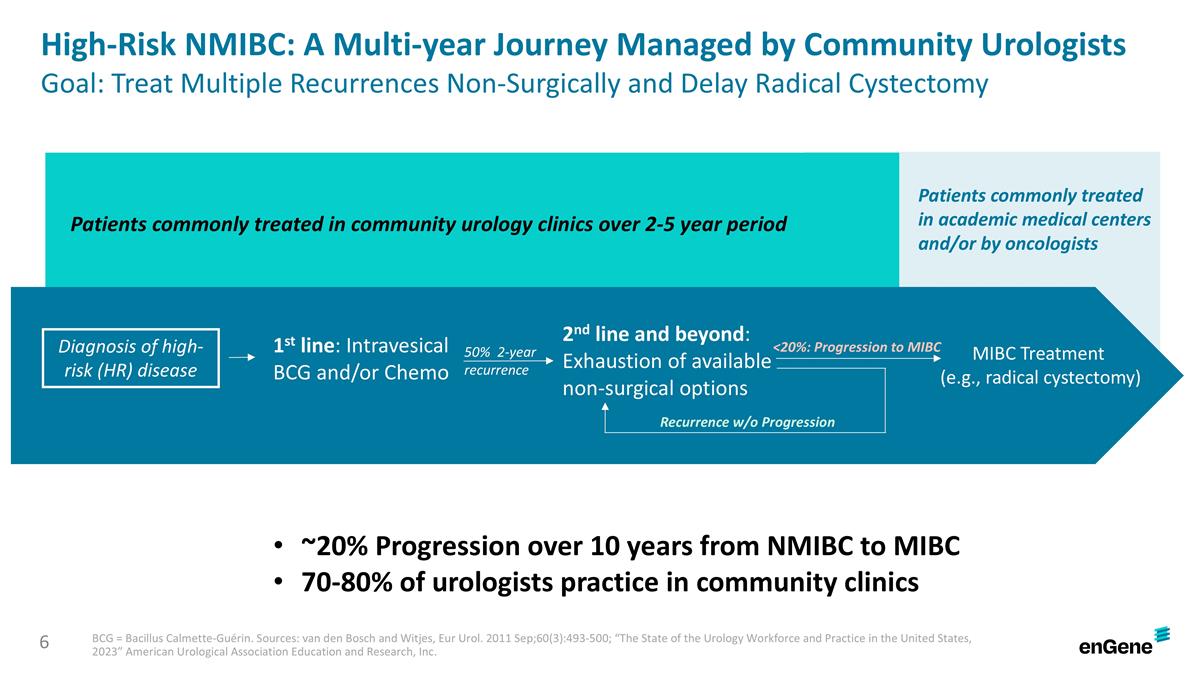
High-Risk NMIBC: A Multi-year Journey Managed by Community Urologists Goal: Treat Multiple Recurrences Non-Surgically and Delay Radical Cystectomy Diagnosis of high-risk (HR) disease 1st line: Intravesical BCG and/or Chemo 2nd line and beyond: Exhaustion of available non-surgical options <20%: Progression to MIBC MIBC Treatment (e.g., radical cystectomy) 50% 2-year recurrence Radical Cystectomy Recurrence w/o Progression Patients commonly treated in community urology clinics over 2-5 year period Patients commonly treated in academic medical centers and/or by oncologists ~20% Progression over 10 years from NMIBC to MIBC 70-80% of urologists practice in community clinics BCG = Bacillus Calmette-Guérin. Sources: van den Bosch and Witjes, Eur Urol. 2011 Sep;60(3):493-500; “The State of the Urology Workforce and Practice in the United States, 2023” American Urological Association Education and Research, Inc.
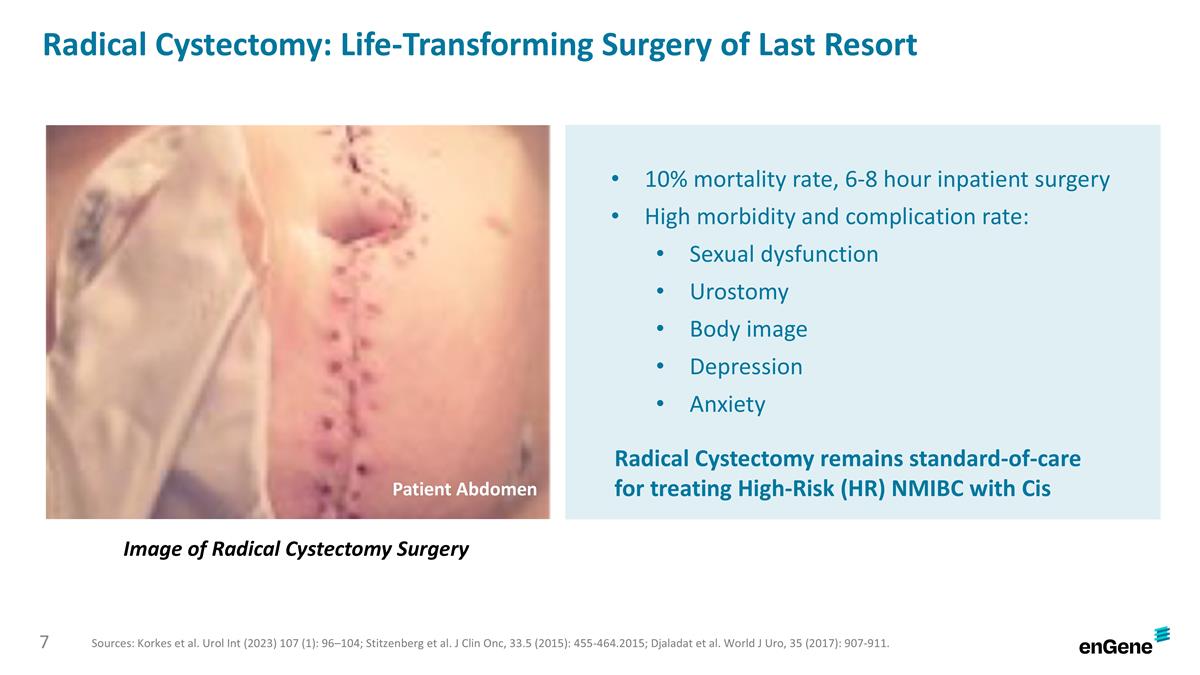
Radical Cystectomy: Life-Transforming Surgery of Last Resort 10% mortality rate, 6-8 hour inpatient surgery High morbidity and complication rate: Sexual dysfunction Urostomy Body image Depression Anxiety Radical Cystectomy remains standard-of-care for treating High-Risk (HR) NMIBC with Cis Image of Radical Cystectomy Surgery Patient Abdomen Sources: Korkes et al. Urol Int (2023) 107 (1): 96–104; Stitzenberg et al. J Clin Onc, 33.5 (2015): 455-464.2015; Djaladat et al. World J Uro, 35 (2017): 907-911.
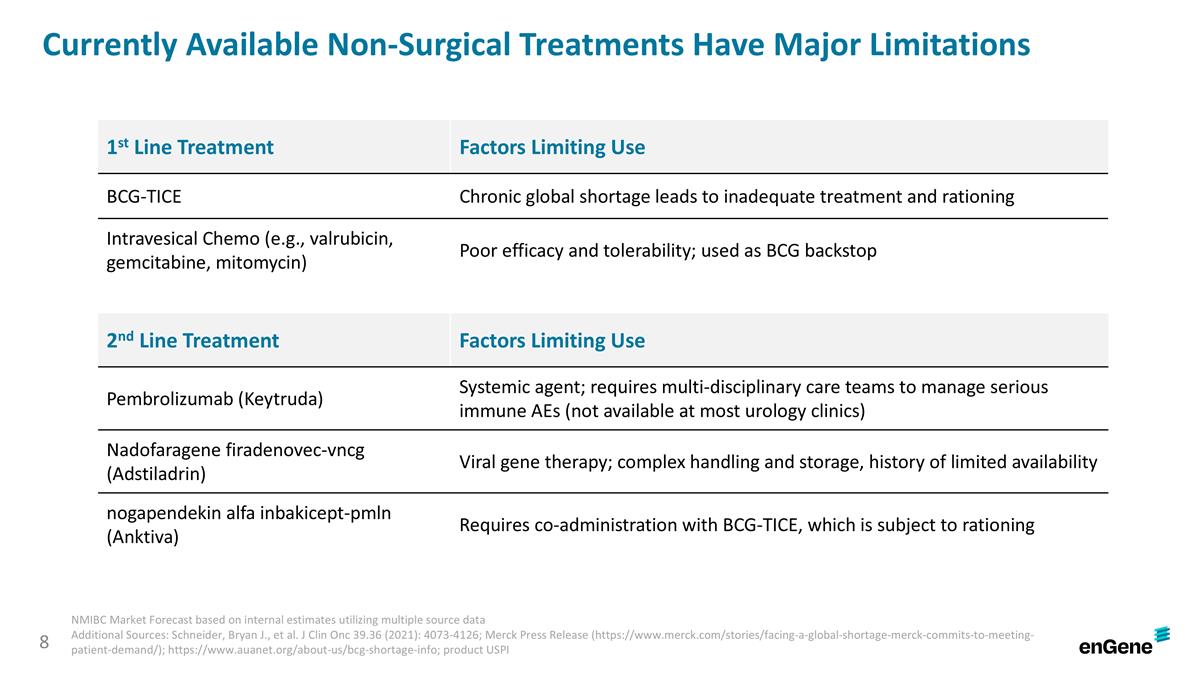
Currently Available Non-Surgical Treatments Have Major Limitations 1st Line Treatment Factors Limiting Use BCG-TICE Chronic global shortage leads to inadequate treatment and rationing Intravesical Chemo (e.g., valrubicin, gemcitabine, mitomycin) Poor efficacy and tolerability; used as BCG backstop 2nd Line Treatment Factors Limiting Use Pembrolizumab (Keytruda) Systemic agent; requires multi-disciplinary care teams to manage serious immune AEs (not available at most urology clinics) Nadofaragene firadenovec-vncg (Adstiladrin) Viral gene therapy; complex handling and storage, history of limited availability nogapendekin alfa inbakicept-pmln (Anktiva) Requires co-administration with BCG-TICE, which is subject to rationing NMIBC Market Forecast based on internal estimates utilizing multiple source data Additional Sources: Schneider, Bryan J., et al. J Clin Onc 39.36 (2021): 4073-4126; Merck Press Release (https://www.merck.com/stories/facing-a-global-shortage-merck-commits-to-meeting-patient-demand/); https://www.auanet.org/about-us/bcg-shortage-info; product USPI
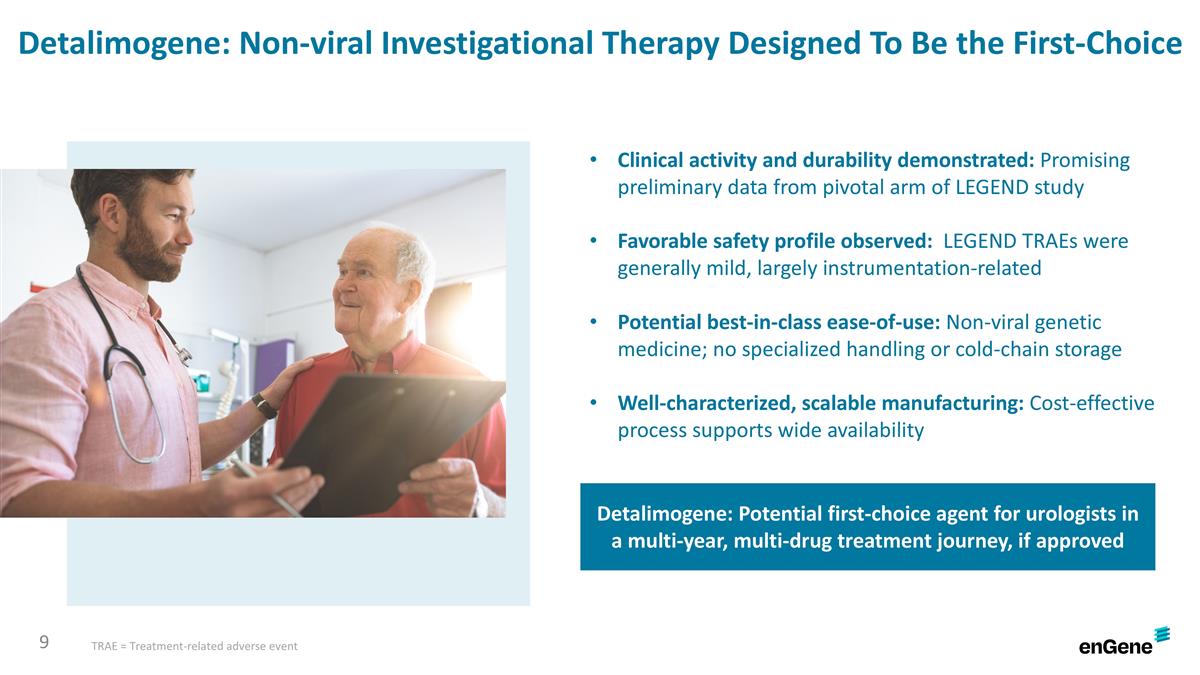
Detalimogene: Potential first-choice agent for urologists in a multi-year, multi-drug treatment journey, if approved Clinical activity and durability demonstrated: Promising preliminary data from pivotal arm of LEGEND study Favorable safety profile observed: LEGEND TRAEs were generally mild, largely instrumentation-related Potential best-in-class ease-of-use: Non-viral genetic medicine; no specialized handling or cold-chain storage Well-characterized, scalable manufacturing: Cost-effective process supports wide availability Detalimogene: Non-viral Investigational Therapy Designed To Be the First-Choice TRAE = Treatment-related adverse event
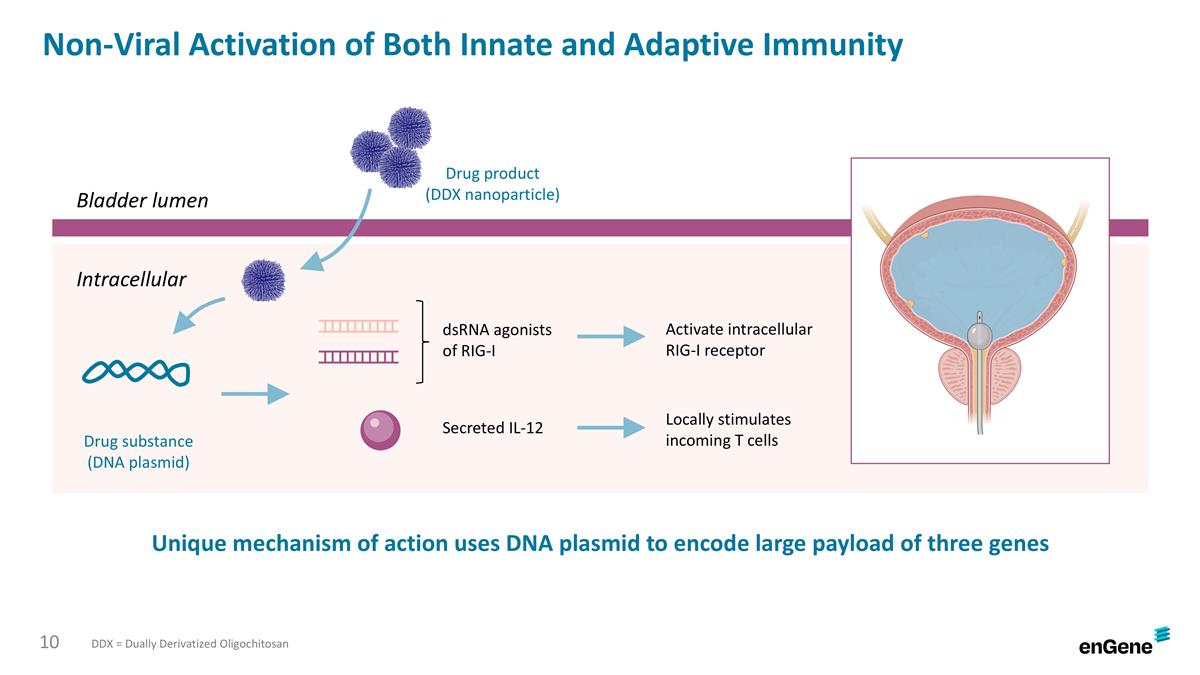
Non-Viral Activation of Both Innate and Adaptive Immunity Unique mechanism of action uses DNA plasmid to encode large payload of three genes Bladder lumen Intracellular Drug product (DDX nanoparticle) Drug substance (DNA plasmid) dsRNA agonists of RIG-I Secreted IL-12 Activate intracellular RIG-I receptor Locally stimulates incoming T cells DDX = Dually Derivatized Oligochitosan
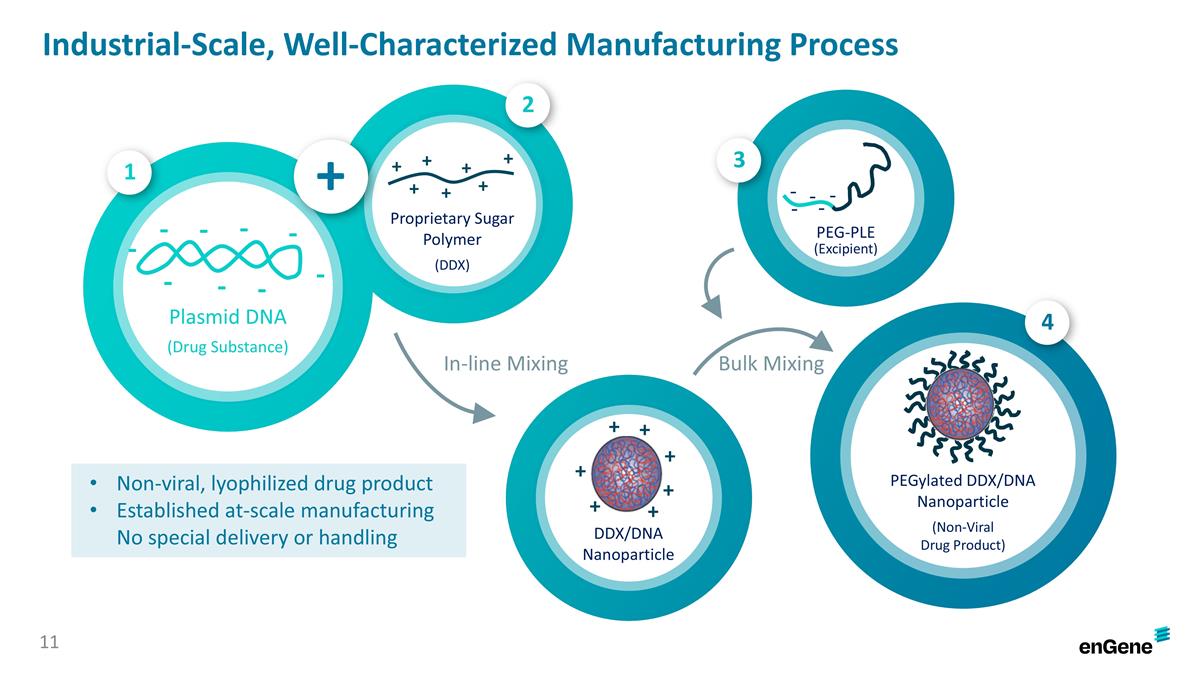
e e e e e - - - - - (Excipient) PEG-PLE Bulk Mixing In-line Mixing PEGylated DDX/DNA Nanoparticle (Non-Viral Drug Product) DDX/DNA Nanoparticle + + + + + + + Non-viral, lyophilized drug product Established at-scale manufacturing No special delivery or handling + + + + + + + Proprietary Sugar Polymer (DDX) Plasmid DNA (Drug Substance) - - - - - - - - - + 2 4 3 1 Industrial-Scale, Well-Characterized Manufacturing Process
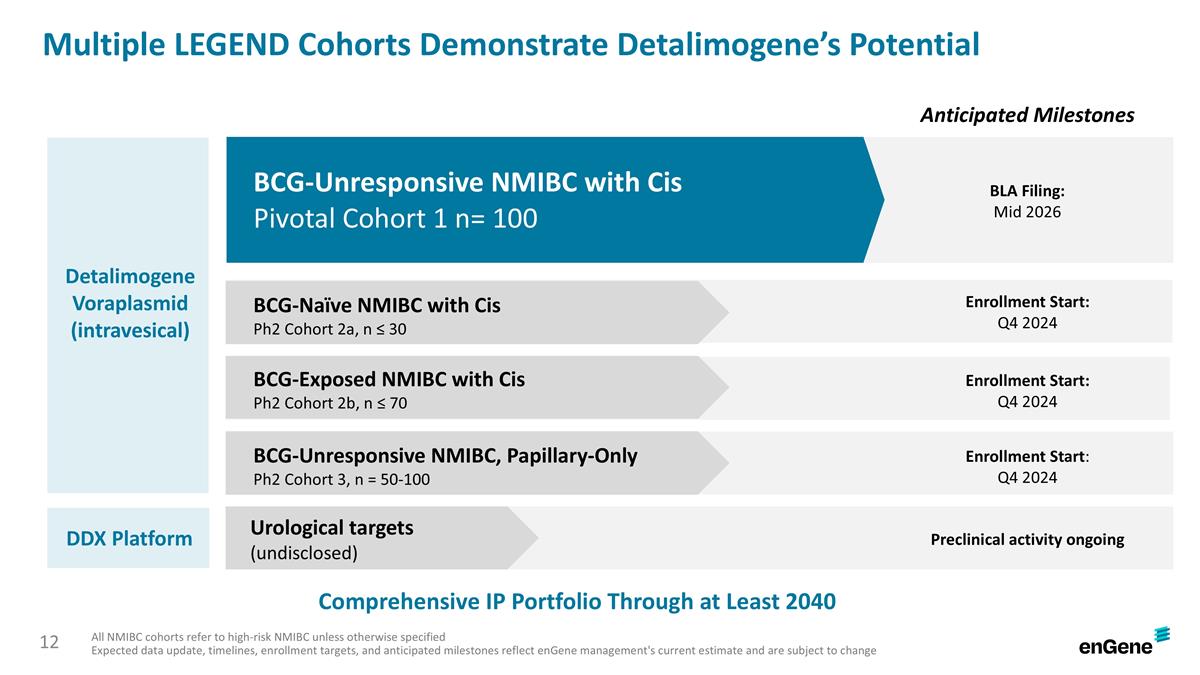
Multiple LEGEND Cohorts Demonstrate Detalimogene’s Potential All NMIBC cohorts refer to high-risk NMIBC unless otherwise specified Expected data update, timelines, enrollment targets, and anticipated milestones reflect enGene management's current estimate and are subject to change Anticipated Milestones Detalimogene Voraplasmid (intravesical) BCG-Unresponsive NMIBC with Cis Pivotal Cohort 1 n= 100 BCG-Naïve NMIBC with Cis Ph2 Cohort 2a, n ≤ 30 BCG-Exposed NMIBC with Cis Ph2 Cohort 2b, n ≤ 70 BCG-Unresponsive NMIBC, Papillary-Only Ph2 Cohort 3, n = 50-100 Enrollment Start: Q4 2024 BLA Filing: Mid 2026 Enrollment Start: Q4 2024 Enrollment Start: Q4 2024 DDX Platform Preclinical activity ongoing Urological targets (undisclosed) Comprehensive IP Portfolio Through at Least 2040
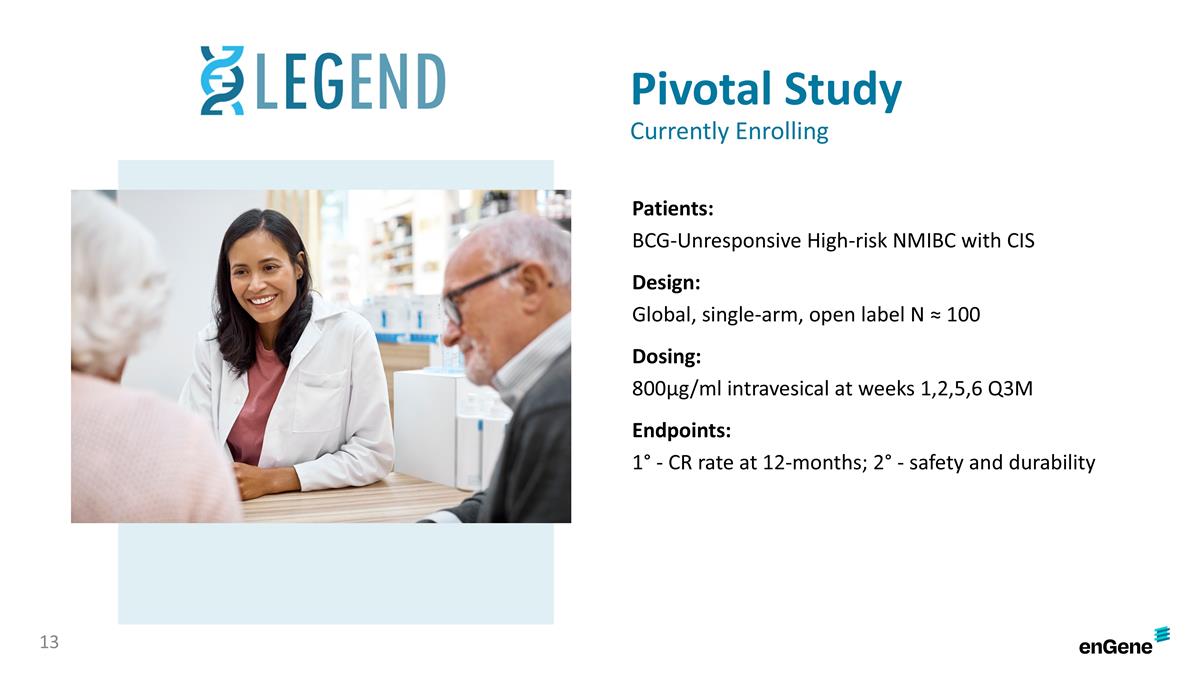
Pivotal Study Currently Enrolling Patients: BCG-Unresponsive High-risk NMIBC with CIS Design: Global, single-arm, open label N ≈ 100 Dosing: 800μg/ml intravesical at weeks 1,2,5,6 Q3M Endpoints: 1° - CR rate at 12-months; 2° - safety and durability
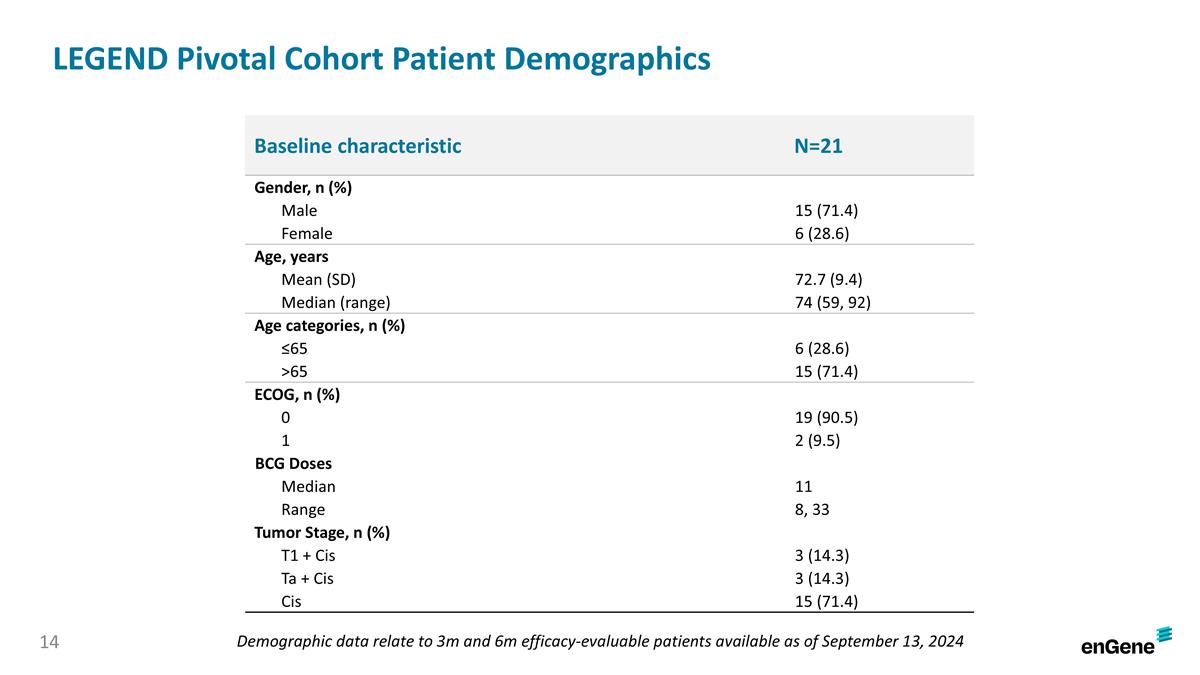
LEGEND Pivotal Cohort Patient Demographics Baseline characteristic N=21 Gender, n (%) Male 15 (71.4) Female 6 (28.6) Age, years Mean (SD) 72.7 (9.4) Median (range) 74 (59, 92) Age categories, n (%) ≤65 6 (28.6) >65 15 (71.4) ECOG, n (%) 0 19 (90.5) 1 2 (9.5) BCG Doses Median 11 Range 8, 33 Tumor Stage, n (%) T1 + Cis 3 (14.3) Ta + Cis 3 (14.3) Cis 15 (71.4) Demographic data relate to 3m and 6m efficacy-evaluable patients available as of September 13, 2024
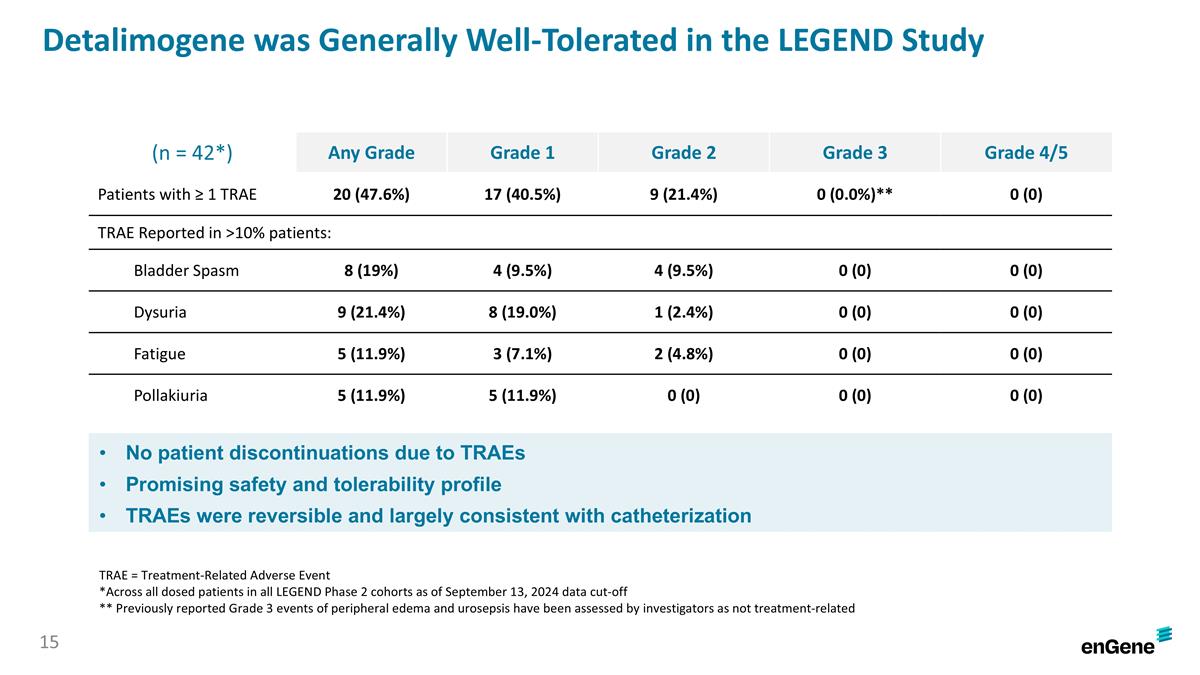
Detalimogene was Generally Well-Tolerated in the LEGEND Study (n = 42*) Any Grade Grade 1 Grade 2 Grade 3 Grade 4/5 Patients with ≥ 1 TRAE 20 (47.6%) 17 (40.5%) 9 (21.4%) 0 (0.0%)** 0 (0) TRAE Reported in >10% patients: Bladder Spasm 8 (19%) 4 (9.5%) 4 (9.5%) 0 (0) 0 (0) Dysuria 9 (21.4%) 8 (19.0%) 1 (2.4%) 0 (0) 0 (0) Fatigue 5 (11.9%) 3 (7.1%) 2 (4.8%) 0 (0) 0 (0) Pollakiuria 5 (11.9%) 5 (11.9%) 0 (0) 0 (0) 0 (0) No patient discontinuations due to TRAEs Promising safety and tolerability profile TRAEs were reversible and largely consistent with catheterization TRAE = Treatment-Related Adverse Event *Across all dosed patients in all LEGEND Phase 2 cohorts as of September 13, 2024 data cut-off ** Previously reported Grade 3 events of peripheral edema and urosepsis have been assessed by investigators as not treatment-related
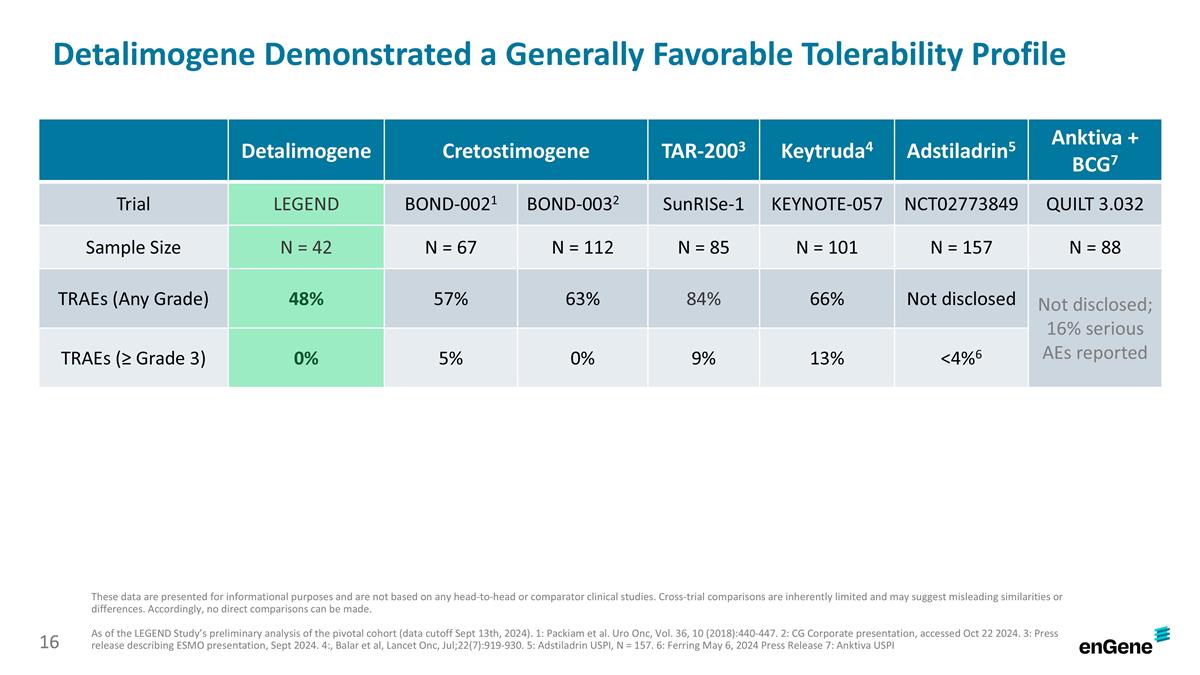
Detalimogene Demonstrated a Generally Favorable Tolerability Profile Detalimogene Cretostimogene TAR-2003 Keytruda4 Adstiladrin5 Anktiva + BCG7 Trial LEGEND BOND-0021 BOND-0032 SunRISe-1 KEYNOTE-057 NCT02773849 QUILT 3.032 Sample Size N = 42 N = 67 N = 112 N = 85 N = 101 N = 157 N = 88 TRAEs (Any Grade) 48% 57% 63% 84% 66% Not disclosed Not disclosed; 16% serious AEs reported TRAEs (≥ Grade 3) 0% 5% 0% 9% 13% <4%6 These data are presented for informational purposes and are not based on any head-to-head or comparator clinical studies. Cross-trial comparisons are inherently limited and may suggest misleading similarities or differences. Accordingly, no direct comparisons can be made. As of the LEGEND Study’s preliminary analysis of the pivotal cohort (data cutoff Sept 13th, 2024). 1: Packiam et al. Uro Onc, Vol. 36, 10 (2018):440-447. 2: CG Corporate presentation, accessed Oct 22 2024. 3: Press release describing ESMO presentation, Sept 2024. 4:, Balar et al, Lancet Onc, Jul;22(7):919-930. 5: Adstiladrin USPI, N = 157. 6: Ferring May 6, 2024 Press Release 7: Anktiva USPI
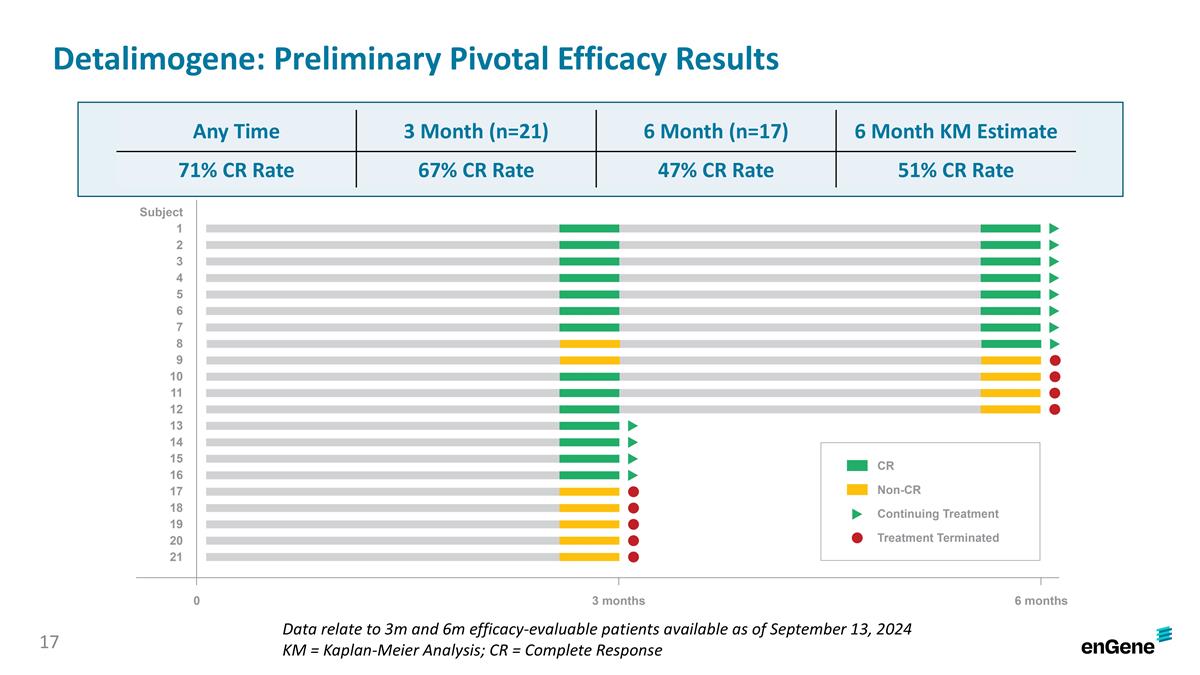
Detalimogene: Preliminary Pivotal Efficacy Results Data relate to 3m and 6m efficacy-evaluable patients available as of September 13, 2024 KM = Kaplan-Meier Analysis; CR = Complete Response Any Time 3 Month (n=21) 6 Month (n=17) 6 Month KM Estimate 71% CR Rate 67% CR Rate 47% CR Rate 51% CR Rate
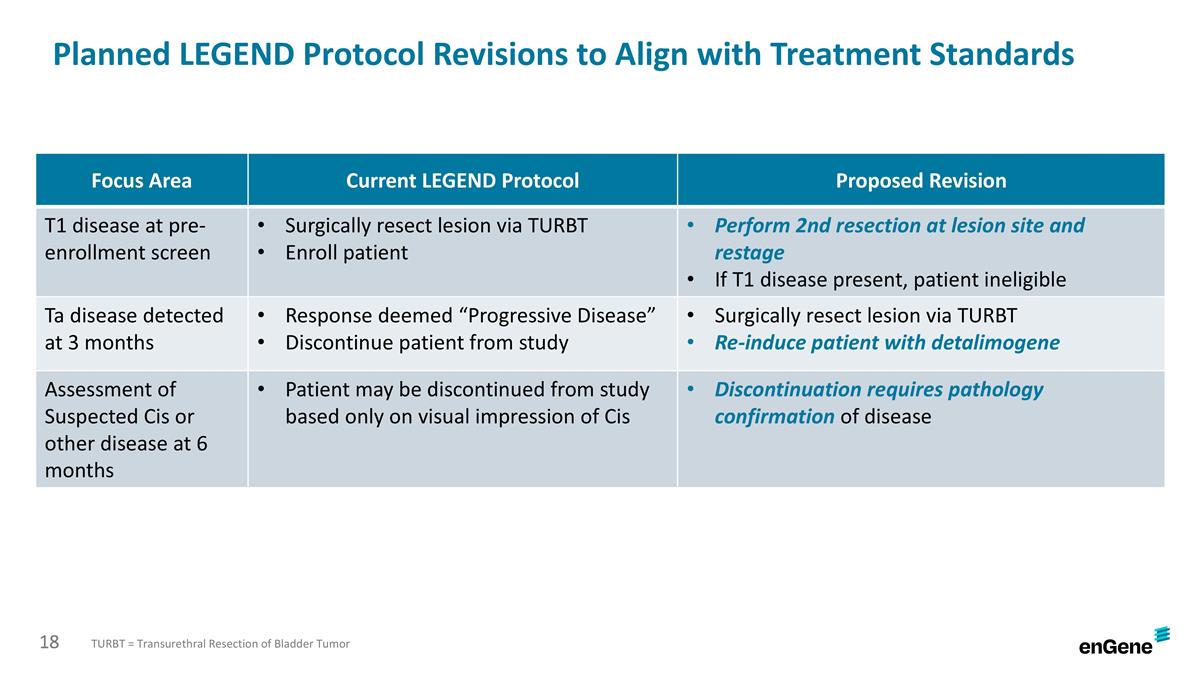
Planned LEGEND Protocol Revisions to Align with Treatment Standards Focus Area Current LEGEND Protocol Proposed Revision T1 disease at pre-enrollment screen Surgically resect lesion via TURBT Enroll patient Perform 2nd resection at lesion site and restage If T1 disease present, patient ineligible Ta disease detected at 3 months Response deemed “Progressive Disease” Discontinue patient from study Surgically resect lesion via TURBT Re-induce patient with detalimogene Assessment of Suspected Cis or other disease at 6 months Patient may be discontinued from study based only on visual impression of Cis Discontinuation requires pathology confirmation of disease TURBT = Transurethral Resection of Bladder Tumor
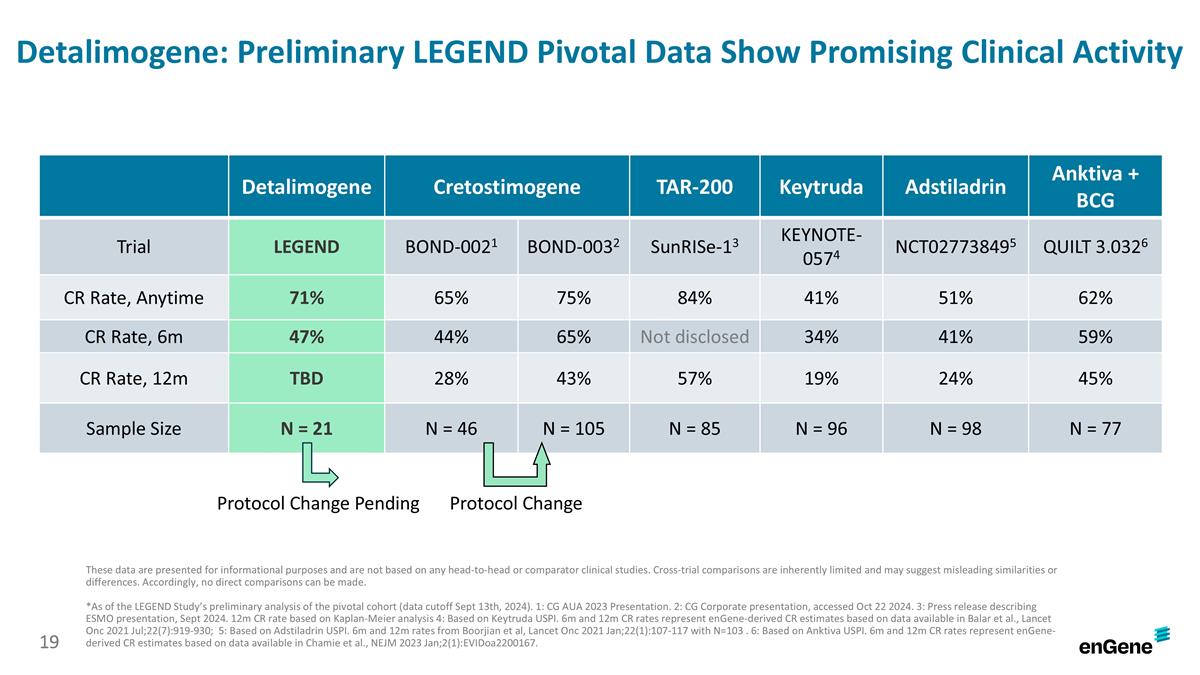
Detalimogene: Preliminary LEGEND Pivotal Data Show Promising Clinical Activity Detalimogene Cretostimogene TAR-200 Keytruda Adstiladrin Anktiva + BCG Trial LEGEND BOND-0021 BOND-0032 SunRISe-13 KEYNOTE-0574 NCT027738495 QUILT 3.0326 CR Rate, Anytime 71% 65% 75% 84% 41% 51% 62% CR Rate, 6m 47% 44% 65% Not disclosed 34% 41% 59% CR Rate, 12m TBD 28% 43% 57% 19% 24% 45% Sample Size N = 21 N = 46 N = 105 N = 85 N = 96 N = 98 N = 77 These data are presented for informational purposes and are not based on any head-to-head or comparator clinical studies. Cross-trial comparisons are inherently limited and may suggest misleading similarities or differences. Accordingly, no direct comparisons can be made. *As of the LEGEND Study’s preliminary analysis of the pivotal cohort (data cutoff Sept 13th, 2024). 1: CG AUA 2023 Presentation. 2: CG Corporate presentation, accessed Oct 22 2024. 3: Press release describing ESMO presentation, Sept 2024. 12m CR rate based on Kaplan-Meier analysis 4: Based on Keytruda USPI. 6m and 12m CR rates represent enGene-derived CR estimates based on data available in Balar et al., Lancet Onc 2021 Jul;22(7):919-930; 5: Based on Adstiladrin USPI. 6m and 12m rates from Boorjian et al, Lancet Onc 2021 Jan;22(1):107-117 with N=103 . 6: Based on Anktiva USPI. 6m and 12m CR rates represent enGene-derived CR estimates based on data available in Chamie et al., NEJM 2023 Jan;2(1):EVIDoa2200167. Protocol Change Protocol Change Pending
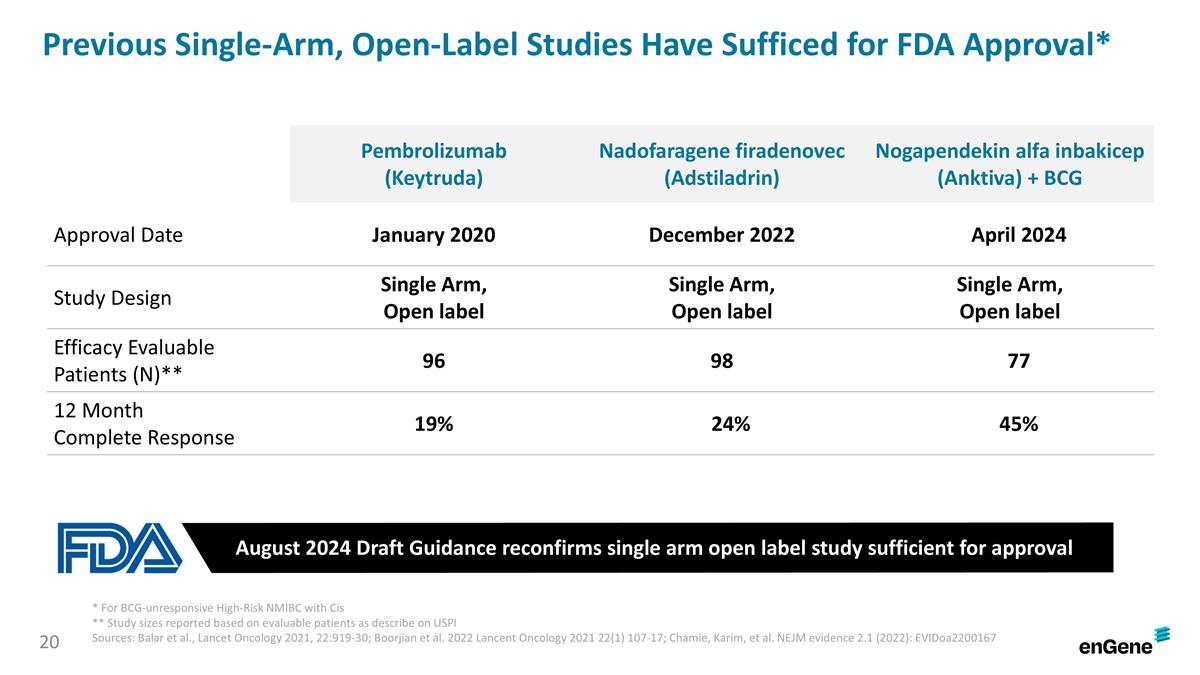
Pembrolizumab (Keytruda) Nadofaragene firadenovec (Adstiladrin) Nogapendekin alfa inbakicep (Anktiva) + BCG Approval Date January 2020 December 2022 April 2024 Study Design Single Arm, Open label Single Arm, Open label Single Arm, Open label Efficacy Evaluable Patients (N)** 96 98 77 12 Month Complete Response 19% 24% 45% August 2024 Draft Guidance reconfirms single arm open label study sufficient for approval Previous Single-Arm, Open-Label Studies Have Sufficed for FDA Approval* * For BCG-unresponsive High-Risk NMIBC with Cis ** Study sizes reported based on evaluable patients as describe on USPI Sources: Balar et al., Lancet Oncology 2021, 22:919-30; Boorjian et al. 2022 Lancent Oncology 2021 22(1) 107-17; Chamie, Karim, et al. NEJM evidence 2.1 (2022): EVIDoa2200167
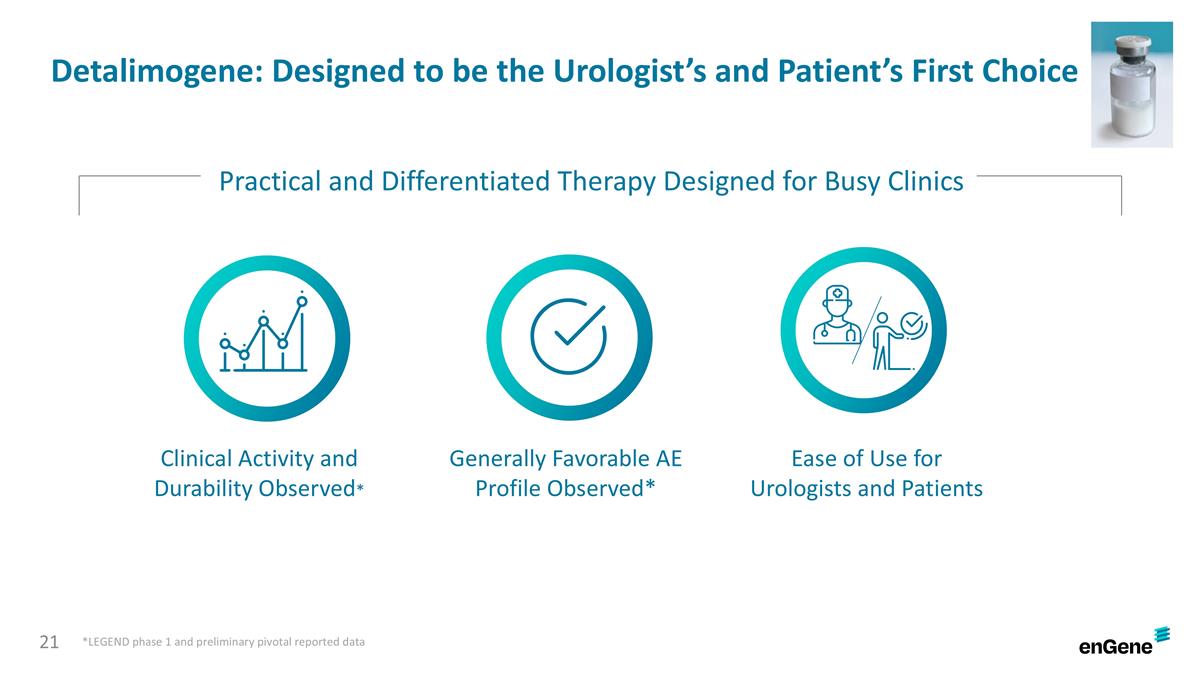
Clinical Activity and Durability Observed* Ease of Use for Urologists and Patients Generally Favorable AE Profile Observed* Practical and Differentiated Therapy Designed for Busy Clinics Detalimogene: Designed to be the Urologist’s and Patient’s First Choice *LEGEND phase 1 and preliminary pivotal reported data
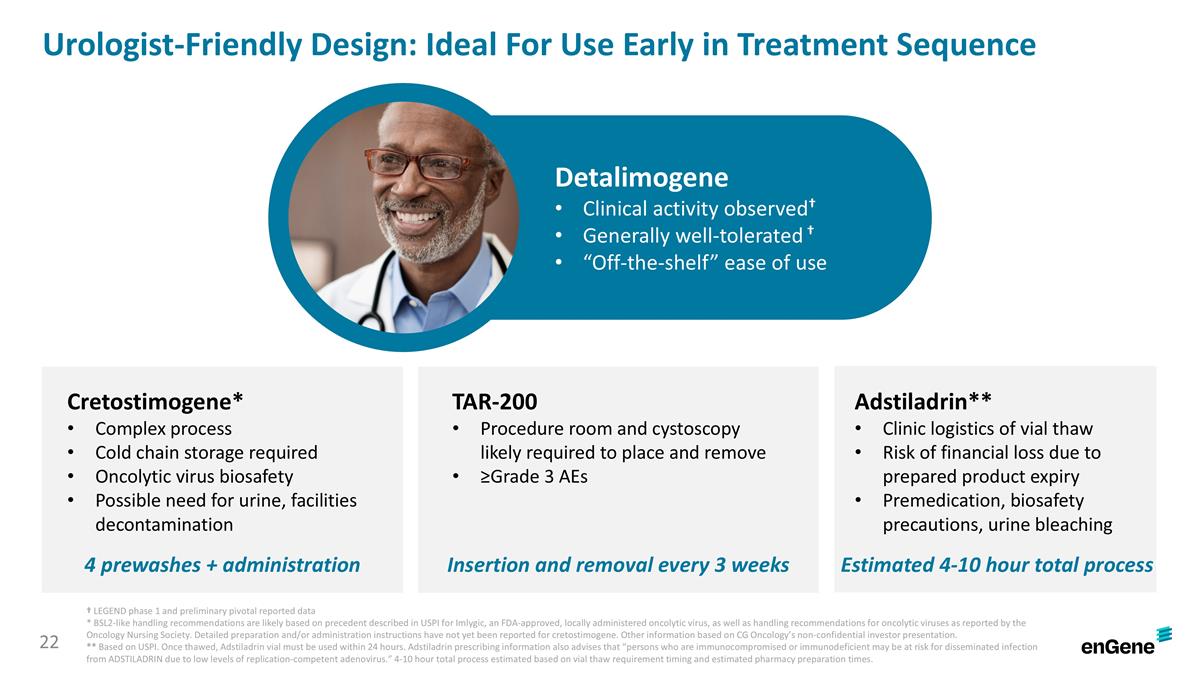
Adstiladrin** Clinic logistics of vial thaw Risk of financial loss due to prepared product expiry Premedication, biosafety precautions, urine bleaching TAR-200 Procedure room and cystoscopy likely required to place and remove ≥Grade 3 AEs Detalimogene Clinical activity observed† Generally well-tolerated † “Off-the-shelf” ease of use Urologist-Friendly Design: Ideal For Use Early in Treatment Sequence 4 prewashes + administration Insertion and removal every 3 weeks Estimated 4-10 hour total process † LEGEND phase 1 and preliminary pivotal reported data * BSL2-like handling recommendations are likely based on precedent described in USPI for Imlygic, an FDA-approved, locally administered oncolytic virus, as well as handling recommendations for oncolytic viruses as reported by the Oncology Nursing Society. Detailed preparation and/or administration instructions have not yet been reported for cretostimogene. Other information based on CG Oncology’s non-confidential investor presentation. ** Based on USPI. Once thawed, Adstiladrin vial must be used within 24 hours. Adstiladrin prescribing information also advises that “persons who are immunocompromised or immunodeficient may be at risk for disseminated infection from ADSTILADRIN due to low levels of replication-competent adenovirus.” 4-10 hour total process estimated based on vial thaw requirement timing and estimated pharmacy preparation times. Cretostimogene* Complex process Cold chain storage required Oncolytic virus biosafety Possible need for urine, facilities decontamination
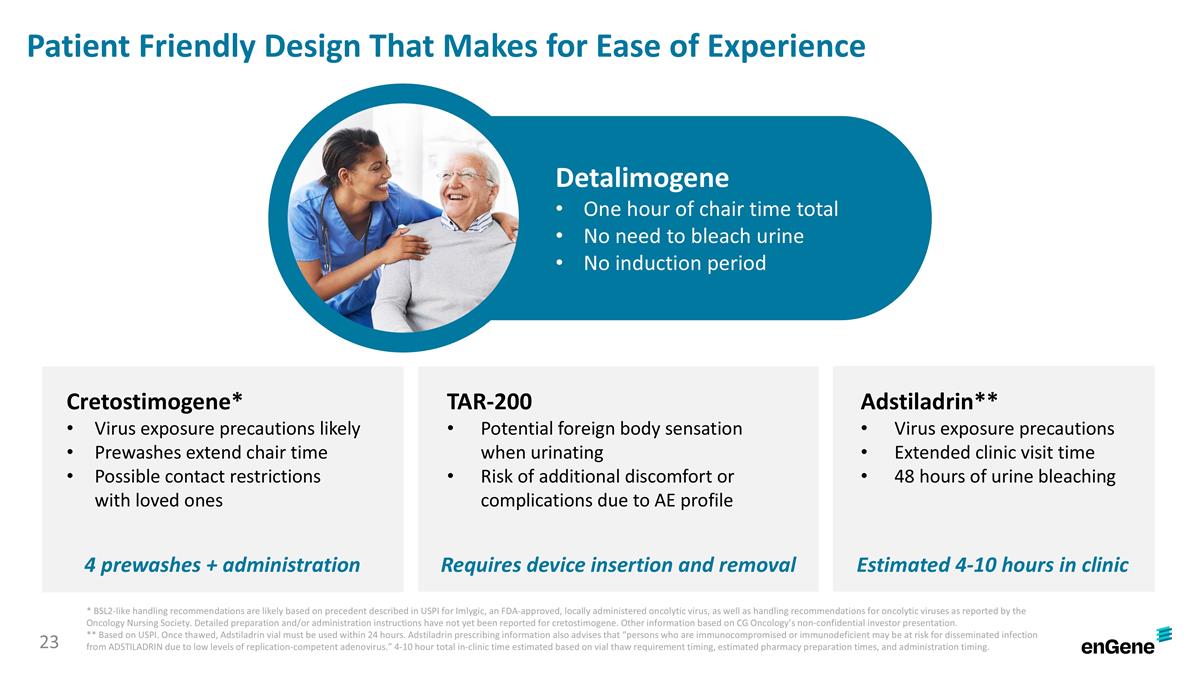
Adstiladrin** Virus exposure precautions Extended clinic visit time 48 hours of urine bleaching TAR-200 Potential foreign body sensation when urinating Risk of additional discomfort or complications due to AE profile Cretostimogene* Virus exposure precautions likely Prewashes extend chair time Possible contact restrictions with loved ones Detalimogene One hour of chair time total No need to bleach urine No induction period Patient Friendly Design That Makes for Ease of Experience * BSL2-like handling recommendations are likely based on precedent described in USPI for Imlygic, an FDA-approved, locally administered oncolytic virus, as well as handling recommendations for oncolytic viruses as reported by the Oncology Nursing Society. Detailed preparation and/or administration instructions have not yet been reported for cretostimogene. Other information based on CG Oncology’s non-confidential investor presentation. ** Based on USPI. Once thawed, Adstiladrin vial must be used within 24 hours. Adstiladrin prescribing information also advises that “persons who are immunocompromised or immunodeficient may be at risk for disseminated infection from ADSTILADRIN due to low levels of replication-competent adenovirus.” 4-10 hour total in-clinic time estimated based on vial thaw requirement timing, estimated pharmacy preparation times, and administration timing. 4 prewashes + administration Requires device insertion and removal Estimated 4-10 hours in clinic
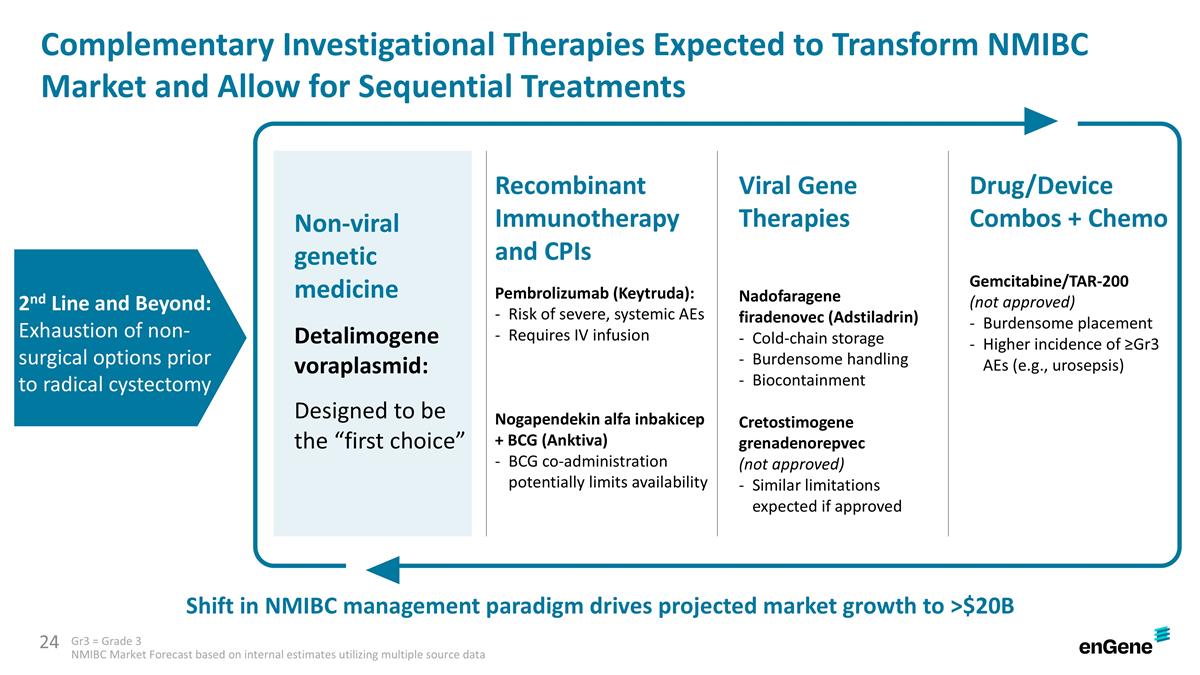
Drug/Device Combos + Chemo Gemcitabine/TAR-200 (not approved) Burdensome placement Higher incidence of ≥Gr3 AEs (e.g., urosepsis) Recombinant Immunotherapy and CPIs Pembrolizumab (Keytruda): Risk of severe, systemic AEs Requires IV infusion Nogapendekin alfa inbakicep + BCG (Anktiva) BCG co-administration potentially limits availability Non-viral genetic medicine Detalimogene voraplasmid: Designed to be the “first choice” Complementary Investigational Therapies Expected to Transform NMIBC Market and Allow for Sequential Treatments Shift in NMIBC management paradigm drives projected market growth to >$20B Gr3 = Grade 3 NMIBC Market Forecast based on internal estimates utilizing multiple source data Viral Gene Therapies Nadofaragene firadenovec (Adstiladrin) Cold-chain storage Burdensome handling Biocontainment Cretostimogene grenadenorepvec (not approved) Similar limitations expected if approved 2nd Line and Beyond: Exhaustion of non-surgical options prior to radical cystectomy
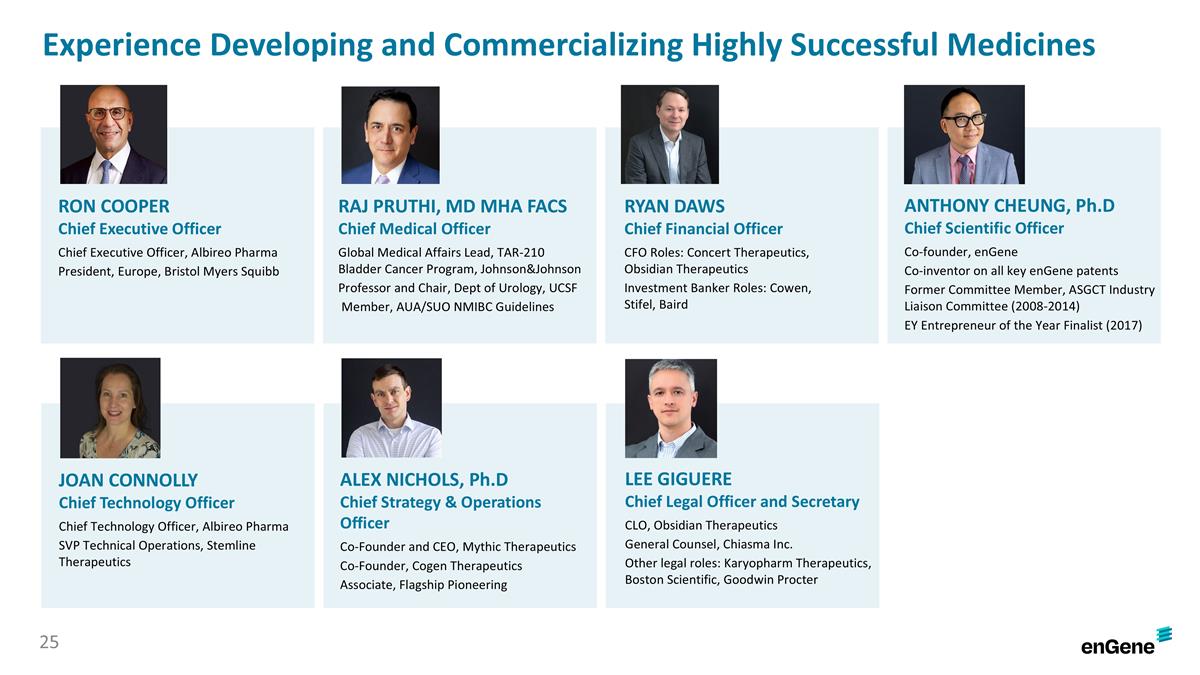
Experience Developing and Commercializing Highly Successful Medicines RAJ PRUTHI, MD MHA FACS Chief Medical Officer Global Medical Affairs Lead, TAR-210 Bladder Cancer Program, Johnson&Johnson Professor and Chair, Dept of Urology, UCSF Member, AUA/SUO NMIBC Guidelines RON COOPER Chief Executive Officer Chief Executive Officer, Albireo Pharma President, Europe, Bristol Myers Squibb RYAN DAWS Chief Financial Officer CFO Roles: Concert Therapeutics, Obsidian Therapeutics Investment Banker Roles: Cowen, Stifel, Baird ANTHONY CHEUNG, Ph.D Chief Scientific Officer Co-founder, enGene Co-inventor on all key enGene patents Former Committee Member, ASGCT Industry Liaison Committee (2008-2014) EY Entrepreneur of the Year Finalist (2017) ALEX NICHOLS, Ph.D Chief Strategy & Operations Officer Co-Founder and CEO, Mythic Therapeutics Co-Founder, Cogen Therapeutics Associate, Flagship Pioneering LEE GIGUERE Chief Legal Officer and Secretary CLO, Obsidian Therapeutics General Counsel, Chiasma Inc. Other legal roles: Karyopharm Therapeutics, Boston Scientific, Goodwin Procter JOAN CONNOLLY Chief Technology Officer Chief Technology Officer, Albireo Pharma SVP Technical Operations, Stemline Therapeutics
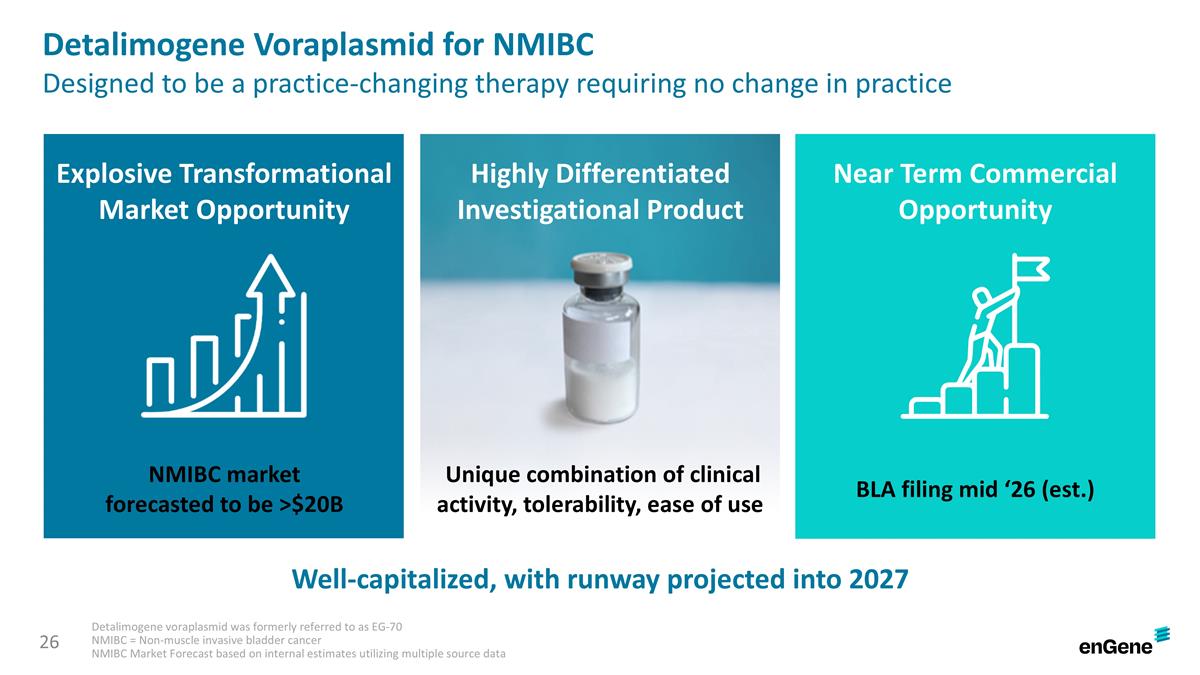
Detalimogene Voraplasmid for NMIBC Designed to be a practice-changing therapy requiring no change in practice Detalimogene voraplasmid was formerly referred to as EG-70 NMIBC = Non-muscle invasive bladder cancer NMIBC Market Forecast based on internal estimates utilizing multiple source data Highly Differentiated Investigational Product Explosive Transformational Market Opportunity Near Term Commercial Opportunity Well-capitalized, with runway projected into 2027 BLA filing mid ‘26 (est.) Unique combination of clinical activity, tolerability, ease of use NMIBC market forecasted to be >$20B
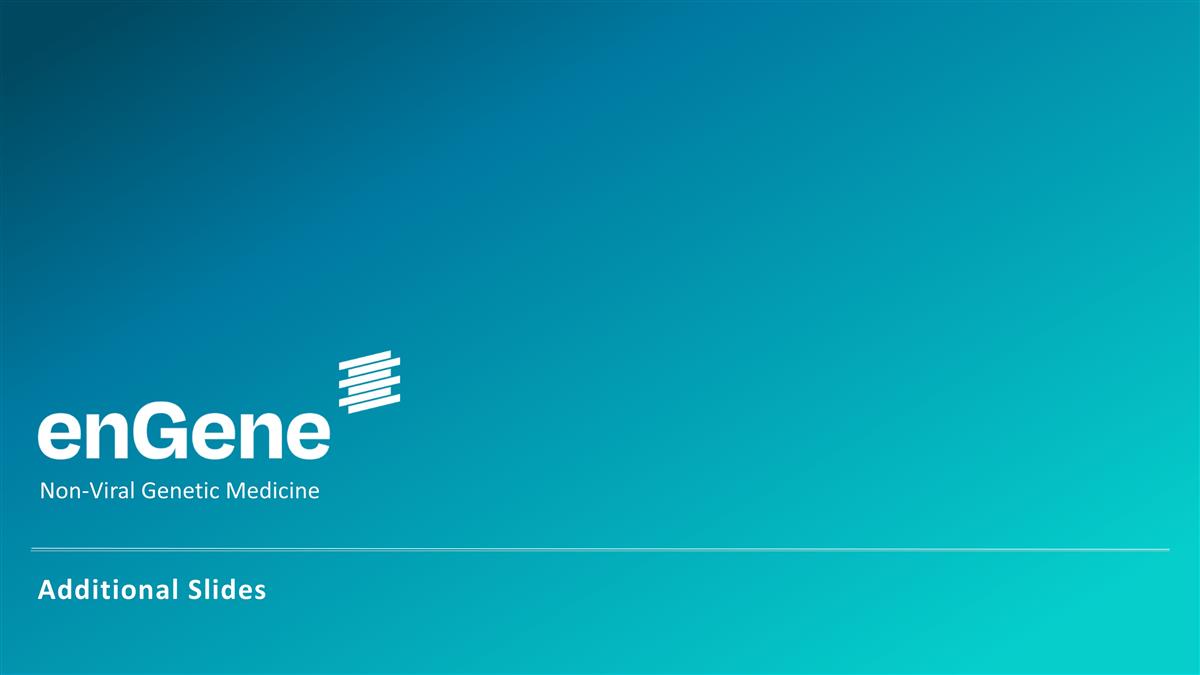
Non-Viral Genetic Medicine Additional Slides
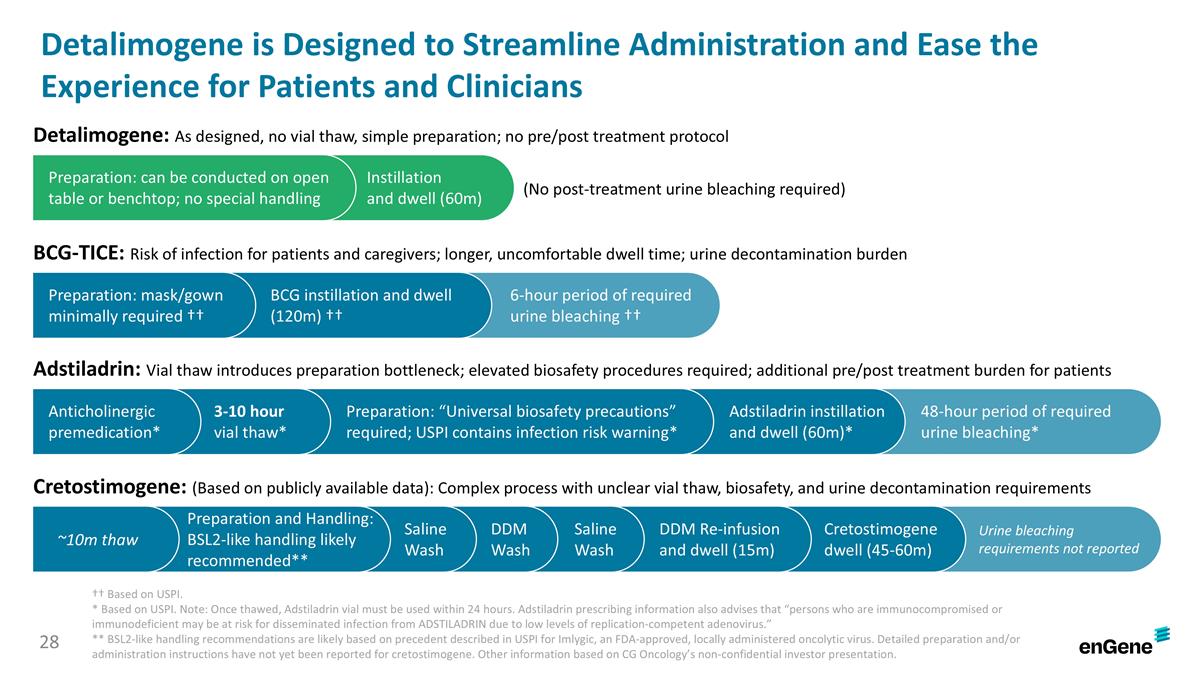
Detalimogene is Designed to Streamline Administration and Ease the Experience for Patients and Clinicians †† Based on USPI. * Based on USPI. Note: Once thawed, Adstiladrin vial must be used within 24 hours. Adstiladrin prescribing information also advises that “persons who are immunocompromised or immunodeficient may be at risk for disseminated infection from ADSTILADRIN due to low levels of replication-competent adenovirus.” ** BSL2-like handling recommendations are likely based on precedent described in USPI for Imlygic, an FDA-approved, locally administered oncolytic virus. Detailed preparation and/or administration instructions have not yet been reported for cretostimogene. Other information based on CG Oncology’s non-confidential investor presentation. Cretostimogene dwell (45-60m) DDM Re-infusion and dwell (15m) Saline Wash DDM Wash Saline Wash Preparation and Handling: BSL2-like handling likely recommended** Cretostimogene: (Based on publicly available data): Complex process with unclear vial thaw, biosafety, and urine decontamination requirements ~10m thaw Urine bleaching requirements not reported Adstiladrin instillation and dwell (60m)* 3-10 hour vial thaw* Adstiladrin: Vial thaw introduces preparation bottleneck; elevated biosafety procedures required; additional pre/post treatment burden for patients Anticholinergic premedication* 48-hour period of required urine bleaching* Preparation: “Universal biosafety precautions” required; USPI contains infection risk warning* 6-hour period of required urine bleaching †† BCG-TICE: Risk of infection for patients and caregivers; longer, uncomfortable dwell time; urine decontamination burden Preparation: mask/gown minimally required †† BCG instillation and dwell (120m) †† Instillation and dwell (60m) Detalimogene: As designed, no vial thaw, simple preparation; no pre/post treatment protocol Preparation: can be conducted on open table or benchtop; no special handling (No post-treatment urine bleaching required)



























